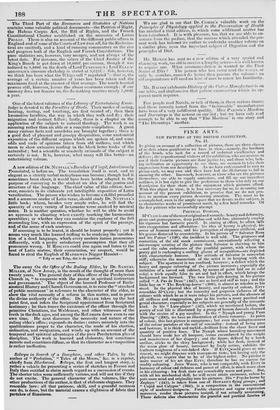A new edition of Dr. Nurra B ucolics off 7rgil,
Interlinearly Translated, is before us. The translation itself is neat, and as elegant as a strictly verbal metaphrase can become; though had it sometimes been closer, it would have been better adapted to the purpose of conveying to the student an idea of the genius and structure of the language. The chief value of this edition, how- ever, consists in its elaborate yet intelligible exposition of Latin versification. The person who wishes to become a skilful prosodist and a sonorous reader of Latin verse, should study Dr. Nurrsee's little book; where, besides very ample rules, he will find the quantity of every variety of hexameter verse marked by musical notes. It is another question, whether he will be able to avoid an approach to chanting when exactly marking the harmonious quantities; or whether they can combine the euphony of the full resounding line, with an expression of the spirit of the passage, and of the sense of each sentence.
If scanning is to be learnt, it should be learnt properly ; yet it seems very much like learned trifling to be studying the versifica- tion of a dead language, which every modern nation pronounces differently, with a pretty satisfactory presumption that they all pronounce wrong. If Rosei us could rise again and listen to the best of Latin orators, their enunciation, we suspect, would be found to rival the English of MATHEWS'S Nigger Hamlet- " Toby or not Toby, dat is de question."
























 Previous page
Previous page